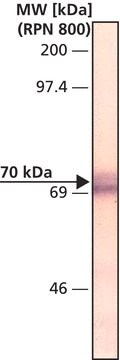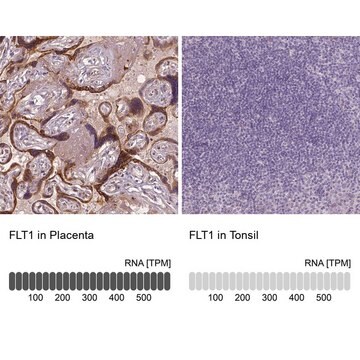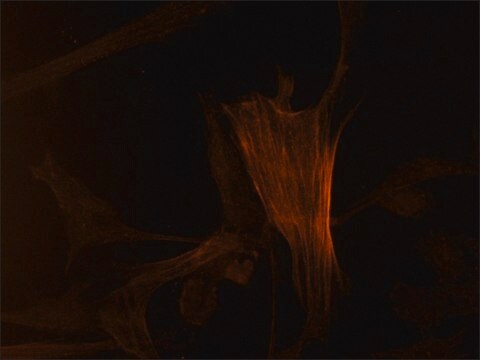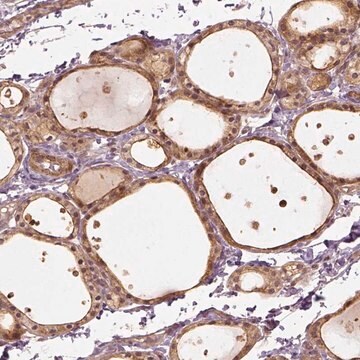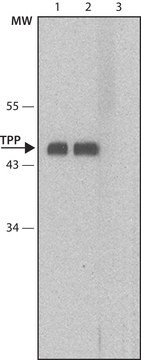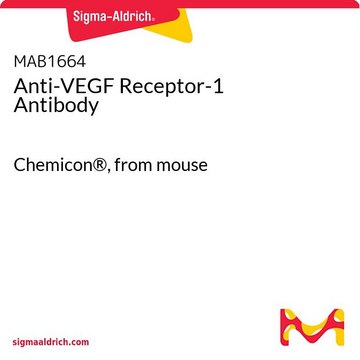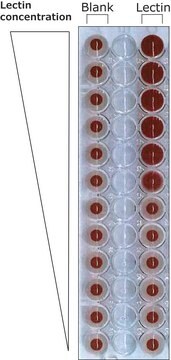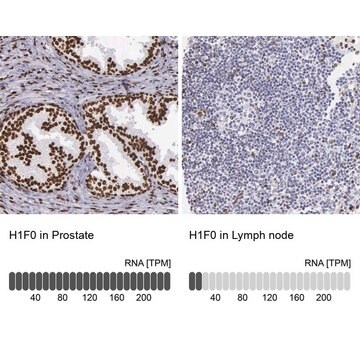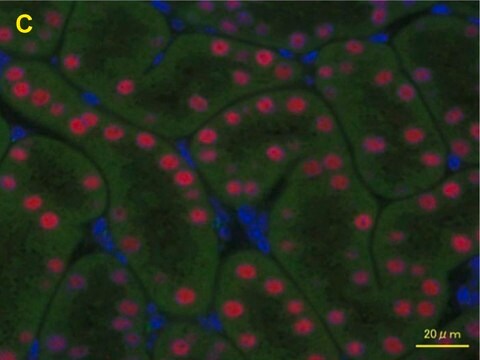おすすめの製品
由来生物
mouse
結合体
unconjugated
抗体製品の状態
tissue culture supernatant
抗体製品タイプ
primary antibodies
クローン
FLT-19, monoclonal
含みます
15 mM sodium azide
交差性
human
テクニック
immunohistochemistry (frozen sections): 1:100 using human placenta
immunoprecipitation (IP): suitable
indirect ELISA: suitable
microarray: suitable
アイソタイプ
IgG1
UniProtアクセッション番号
輸送温度
dry ice
保管温度
−20°C
ターゲットの翻訳後修飾
unmodified
遺伝子情報
human ... FLT1(2321)
詳細
Monoclonal Anti-VEGF Receptor-1 (Flt1 Receptor) (mouse IgG1 isotype) is derived from the FLT-19 hybridoma produced by the fusion of mouse myeloma cells and splenocytes from BALB/c mice immunized with a recombinant extracellular domain of VEGF Receptor-1 (Flt1 Receptor) of human origin. Vascular endothelial growth factor (VEGF), also called vasculotropin (VAS)1 and vascular permeability factor (VPF) 2 is a member of a family of endothelial cell mitogens and angiogenic factors. VEGF is a homodimeric heparin-binding glycoprotein. VEGF binds to two structurally similar receptor tyrosine kinases; Flt15 (fms-like tyrosine kinase 1, also termed VEGF Receptor-1, VEGF-R1) and KDR6 (kinase-insert domain containing receptor, also termed VEGF-R2). Flt1 is predominately expressed in human placenta and human vascular endothelial cells, while KDR is more widely expressed in all vessel-derived endothelial cells but low in human and fetal bovine placenta.
Mouse monoclonal clone FLT-19 anti-Vascular Endothelial Growth Factor Receptor-1 antibody recognizes the extracellular domain of human VEGF Receptor-1 molecule (Flt1 Receptor). The antibody does not recognize VEGF Receptor-2 (KDR), VEGF receptor-3 (sFlt4,) and PDGF-Rβ.
免疫原
VEGFR-1の組み換えヒト細胞外ドメインです。
アプリケーション
Monoclonal Anti-Vascular Endothelial Growth Factor Receptor-1 antibody produced in mouse has been used in:
- immunofluorescence labelling
- enzyme-linked immunosorbent assay (ELISA)
- immunohistochemistry
- immunoprecipitation
Mouse monoclonal clone FLT-19 anti-Vascular Endothelial Growth Factor Receptor-1 antibody may be used for the localization of VEGF-R1 using various immunochemical assays such as ELISA, immunoblotting, immunocytochemistry, immunohistochemistry, and immunoprecipitation. Antibodies that react specifically with VEGF receptors are useful for the study of the specific differential tissue expression and intracellular localization of the receptor in normal and neoplastic tissue.
生物化学的/生理学的作用
The mitogenic activity of VEGF appears to be stimulated by specific VEGF receptors (160-200 kDa) which can be found on the surface of various endothelial cells. VEGF binds to two structurally similar receptor tyrosine kinases; Flt1 (fms-like tyrosine kinase 1, also known as VEGF Receptor-1 (VEGF-R1), and KDR (kinase insert domain containing receptor, also known as VEGF-R2). Studies using KDR and Flt1 stably transfected endothelial cell lines have shown that these two receptors exhibit different affinities to VEGF and mediate different responses. KDR/Flk1 does not respond to placental growth factor (PlGF), a VEGF related growth factor, while Flt1 binds PlGF specifically. Flt1 is predominately expressed in human placenta and human vascular endothelial cells. Both VEGF receptors (KDR and Flt1) are upregulated in human fetal and adult kidney.
Vascular endothelial growth factor (VEGF) stimulates the proliferation of endothelial cells isolated from both small and large vessels.
免責事項
Unless otherwise stated in our catalog or other company documentation accompanying the product(s), our products are intended for research use only and are not to be used for any other purpose, which includes but is not limited to, unauthorized commercial uses, in vitro diagnostic uses, ex vivo or in vivo therapeutic uses or any type of consumption or application to humans or animals.
適切な製品が見つかりませんか。
製品選択ツール.をお試しください
シグナルワード
Warning
危険有害性情報
危険有害性の分類
STOT RE 2
保管分類コード
10 - Combustible liquids
WGK
WGK 3
適用法令
試験研究用途を考慮した関連法令を主に挙げております。化学物質以外については、一部の情報のみ提供しています。 製品を安全かつ合法的に使用することは、使用者の義務です。最新情報により修正される場合があります。WEBの反映には時間を要することがあるため、適宜SDSをご参照ください。
Jan Code
V4762-.5ML:
V4762-.2ML:
V4762-BULK:
V4762-VAR:
Real-time ligand binding of fluorescent VEGF-A isoforms that discriminate between VEGFR2 and NRP1 in living cells
PeachnCJ, et al.
Cell Chemical Biology, 25(10), 1208- 1218 (2018)
Vascular endothelial cell growth factor (VEGF), an emerging target for cancer chemotherapy
Shinkaruk S, et al.
Current Medicinal Chemistry. Anticancer Agents, 3(2), 95-117 (2003)
M Simon et al.
Journal of the American Society of Nephrology : JASN, 9(6), 1032-1044 (1998-06-11)
Vascular endothelial growth factor (VEGF) has an important function in renal vascular ontogenesis and is constitutively expressed in podocytes of the adult kidney. The ability of VEGF to be chemotactic for monocytes and to increase the activity of collagenase and
A Sawano et al.
Blood, 97(3), 785-791 (2001-02-07)
Flt-1, also known as vascular endothelial growth factor receptor 1 (VEGFR-1), is a high-affinity tyrosine kinase receptor for VEGF and is expressed almost exclusively on vascular endothelial cells. As an exception, Flt-1 transcript was recently found to be expressed in
Chloe J Peach et al.
Cell chemical biology, 25(10), 1208-1218 (2018-07-31)
Fluorescent VEGF-A isoforms have been evaluated for their ability to discriminate between VEGFR2 and NRP1 in real-time ligand binding studies in live cells using BRET. To enable this, we synthesized single-site (N-terminal cysteine) labeled versions of VEGF165a, VEGF165b, and VEGF121a.
ライフサイエンス、有機合成、材料科学、クロマトグラフィー、分析など、あらゆる分野の研究に経験のあるメンバーがおります。.
製品に関するお問い合わせはこちら(テクニカルサービス)